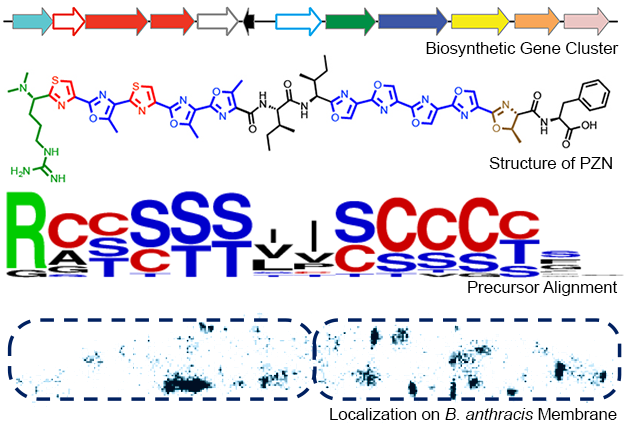In the hunt for improved antibiotics, it is important to realize that natural products have been, without question, the most prolific source of all medicines. With the advent of massively parallel DNA sequencing, it has become apparent that our knowledge of natural product structure and function is astonishingly incomplete. Exploration of uncharted natural product chemical space will undoubtedly lead to improved, and entirely new, medicines. Thus, our group focuses on elucidating the biosynthesis, structure, and function of natural products. Our primary focus has been on thiazole/oxazole-containing peptides. Characterized examples have activities ranging from antibacterials to virulence-promoting toxins. Therefore, the study of these peptidic natural products allows us to not only better understand bacterial virulence (where pharmacological intervention would constitute a pathogen-specific approach to bacterial infection) but also explore unique chemical architectures, ideally positioning us to introduce new structural classes of antibiotics. Our recent successes and focal areas are highlighted below by research project.
plantazolicin

One linear azoline-containing peptide natural product (LAP) that has received a significant amount of our attention is plantazolicin (PZN). This compound is from a soil-dwelling bacterium, Bacillus velezensis (previously classified as Bacillus amyloliquefaciens). In 2008, the biosynthetic gene cluster for PZN was bioinformatically identified; in 2011, we carried out a systematic in vivo dissection of the biosynthetic pathway. In that same year, we determined the chemical structure of PZN using high-resolution MS and multidimensional NMR. This work also revealed an intriguing biological activity for PZN, which displays remarkably selective antibiotic activity against Bacillus anthracis, the causative agent of anthrax. Chemotype-driven bioinformatics methods established that other bacteria produce PZN-like compounds, which now constitute a new structural class of antibiotic.
Studies emerging in 2013, 2016 and 2017 have shed light on the structure-activity relationships for the PZN pharmacophore and demonstrated which parts of PZN are necessary for bioactivity and B. anthracis specificity. A detailed chemical and biological investigation into the mode of action has implicated cardiolipin-rich microdomains of the B. anthracis plasma membrane as the biological target of PZN.
We are working on understanding the biosynthesis and mode-of-action of this Bacillus anthracis (anthrax) - killing molecule.
recent publications
- Si, T. et al., "Profiling of microbial colonies for high-throughput engineering of multi-step enzymatic reactions via optically guided MALDI MS." J. Am. Chem. Soc. (2017) doi:10.1021/jacs.7b04641
- Deane, C.D. et al., "In vitro biosynthesis and substrate tolerance of the plantazolicin family of natural products." ACS Chem. Biol. (2016). doi:10.1021/acschembio.6b00369
- Molohon, K. et al., "Plantazolicin is an ultra-narrow spectrum antibiotic that targets the Bacillus anthracis membrane." ACS Infect. Dis. (2016). doi:10.1021/acsinfecdis.5b00115
- Hao, Y., Blair, P.M., et al., "Insights into methyltransferase specificity and bioactivity of derivatives of the antibiotic plantazolicin" ACS Chem. Biol. (2015). doi:10.1021/cb501042a